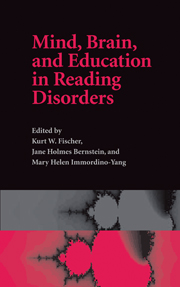Book contents
- Frontmatter
- Contents
- List of figures
- List of tables
- List of contributors
- Acknowledgements
- Part I What is Reading, and What are Reading Disorders? Looking to Neuroscience, Evolution, and Genetics
- Part II Reading and the Growing Brain: Methodology and History
- 4 A brief history of time, phonology, and other explanations of developmental dyslexia
- 5 Approaches to behavioral and neurological research on learning disabilities: in search of a deeper synthesis
- 6 Growth cycles of mind and brain: analyzing developmental pathways of learning disorders
- Essay: Cycles and gradients in development of the cortex
- 7 Brain bases of reading disabilities
- 8 The neural correlates of reading disorder: functional magnetic resonance imaging
- 9 Patterns of cortical connection in children with learning problems
- Essay: The role of experience in brain development: adverse effects of childhood maltreatment
- Part III Watching Children Read
- Part IV Reading Skills in the Long Term
- Appendix: Transcript and behavioral data from Profiles in Reading Skills (Four Boys)
- Index
- References
5 - Approaches to behavioral and neurological research on learning disabilities: in search of a deeper synthesis
Published online by Cambridge University Press: 22 September 2009
- Frontmatter
- Contents
- List of figures
- List of tables
- List of contributors
- Acknowledgements
- Part I What is Reading, and What are Reading Disorders? Looking to Neuroscience, Evolution, and Genetics
- Part II Reading and the Growing Brain: Methodology and History
- 4 A brief history of time, phonology, and other explanations of developmental dyslexia
- 5 Approaches to behavioral and neurological research on learning disabilities: in search of a deeper synthesis
- 6 Growth cycles of mind and brain: analyzing developmental pathways of learning disorders
- Essay: Cycles and gradients in development of the cortex
- 7 Brain bases of reading disabilities
- 8 The neural correlates of reading disorder: functional magnetic resonance imaging
- 9 Patterns of cortical connection in children with learning problems
- Essay: The role of experience in brain development: adverse effects of childhood maltreatment
- Part III Watching Children Read
- Part IV Reading Skills in the Long Term
- Appendix: Transcript and behavioral data from Profiles in Reading Skills (Four Boys)
- Index
- References
Summary
Overview: Progress in understanding learning disabilities requires integration of behavioral and neurological evidence across the main traditions of research on cognitive development – empiricism, rationalism, and the sociohistorical approach. Among the key findings, researchers in the empiricist tradition have uncovered evidence that dyslexic children have specific problems in analyzing the sounds of language and in performing rapid processing and that these problems are reflected in particular brain activation patterns. Those in the rationalist tradition have analyzed the structures and stages required for reading, including general abilities, developmental pathways, and related patterns of development of brain activity. Scholars in the sociohistorical tradition have focused on the effects of culture and social context in the creation and consequences of literacy, including the effects of social stratification and the effectiveness of creating an effective community of learners to support students' literacy.
The EditorsTwo themes run throughout the present volume, and the case material that accompanies it. The first is the need to integrate clinical and research perspectives on learning disabilities. The second is the need for a theoretical framework that comprises both the neuropsychological and the cognitive/behavioral perspectives. Volumes such as the present one are an excellent way to begin the search for a theoretical framework with the degree of generality that is required for these two purposes. However, as we contemplate the shape that such a framework might assume, it is important to remember that behavioral and neuro logical research has itself been conducted within several different traditions.
- Type
- Chapter
- Information
- Mind, Brain, and Education in Reading Disorders , pp. 80 - 100Publisher: Cambridge University PressPrint publication year: 2007
References
- 1
- Cited by



